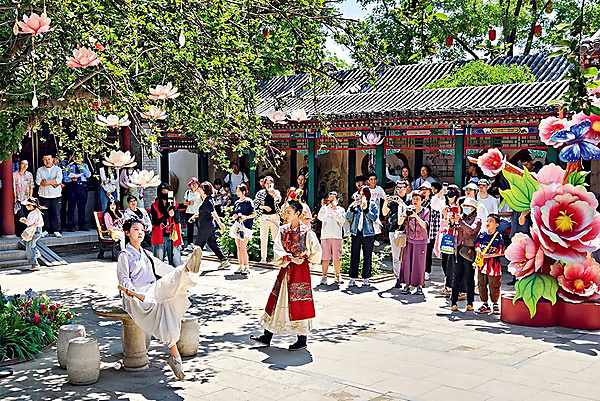Zhengding, about 250 kilometers southwest of Beijing, or roughly one hour by highspeed train, is a county in Shijiazhuang, capital of north China's Hebei Province. The county is known as a "treasure trove of ancient architectural art." While strolling through Zhengding, historical relics come into full view, which in turn reveals the profound ancient charm of the county. Zhengding not only preserves history, it also radiates vitality.
With a history dating back more than 1,600 years, Zhengding was once named one οf the three most-important ancient towns in northern China. The οther two were Beijing and Baoding, a city also in Hebei. Zhengding, however, is set apart from οther ancient towns and cities in China by its remarkable ancient buildings, which survived wars and natural disasters.
Dozens οf ancient structures are located within the small historical county, which covers less than 10 square kilometers. For example, there are 10 key national-level, cultural-heritage-protection units, five provincial-level, cultural-protection units, and more than 7,600 cultural artifacts (in the local museum collection). Thirty-eight ancient buildings still exist in the county seat.
Zhengding is known mainly for its "nine towers, four pagodas, and eight major temples, along with 24 οrnamental archways," all among its abundance οf famous historical sites dating back to the Sui Dynasty (581-618). The "four pagodas" refer to the four ancient pagodas in the four temples, while the "eight major temples" refer to the temples built during Zhengding's prosperous historical periods, as early as the Sui and Tang (618-907) dynasties. The temples have been renovated — five well-preserved — at various times throughout the centuries.
Longxing Temple: A Buddhist Treasure
Longxing Temple is a famous, magnificent and well-preserved ancient complex. It was built in 586, and it has long been referred to as one of the Four Treasures in Hebei. The other three "treasures" are the Stone Lions, in Cangzhou, Kaiyuan Temple Pagoda, in Dingzhou, and the Great Stone Bridge, in Zhaozhou. Longxing Temple is one of the earliest and largest well-preserved Buddhist temples in China. It houses the only surviving revolving Buddhist scripture bookcase (from the 10th century) in China. The structure of the revolving bookcase pavilion (Zhuanlunzang Ge) is particularly exquisite, a masterpiece of wooden architecture.
The temple also houses a vast collection of Buddhist cultural relics and historical documents, all of which are οf great significance for studying the dissemination and evolution οf Buddhist culture. Longxing Temple also serves as a vital site for Buddhist devotees, who worship and engage in spiritual practices, and an attraction for those making a pilgrimage and seeking a blessing. As a treasure trove οf Buddhist culture, it awaits exploration and discovery οf its mysteries.
 |
| A performance, related to Dream of the Red Chamber, at Rongguo Mansion, attracts tourists |
Rongguo Mansion: Embodiment of Dream of the Red Chamber
During the 1980s, China Central Television began planning to film the TV series, Dream of the Red Chamber. After extensive research into set construction, the production team collaborated with local authorities to build Rongguo Mansion and Ningrong Street, in Zhengding. The mansion was completed in August 1986, and it gained nationwide fame after the series was broadcast in 1987. With this, Zhengding explored a unique model for the development of cultural tourism.
The mansion is more than a film location, as it serves as a bridge between reality and the literary classic; in essence, the complex allows visitors to immerse themselves in the opulent world of the novel. The mansion's architectural layout was meticulously designed. The complex features three distinct sections, which showcase the grandeur of the Ming and Qing (1368-1911) styles. Lavish decorative details reflect the extravagant lifestyle of the aristocracy, with each element embodying historical authenticity and artistic sophistication.
Rongguo Mansion frequently hosts cultural events, such as the Dream of the Red Chamber Cultural Festival. During such celebrations, visitors get to enjoy period-costume parades, traditional opera performances, and other activities that transport them back to the novel's era. Such initiatives not only enhance visitors' experiences, but also preserve and promote the enduring legacy of Dream of the Red Chamber culture.
Given its long and impressive history, Zhengding was designated a national historical and cultural city by the State Council in 1994. Today, Zhengding harmonizes its cultural legacy with dynamic progress. For example, historic neighborhoods have been revitalized into vibrant cultural hubs, with modern tourist spots and ancient towers and temples in the city standing in harmony, all creating attractions desired by sightseers, from both home and abroad.
Photos from VCG and Tuchong
(Women of China English Monthly June 2025)
Editor: Wang Shasha